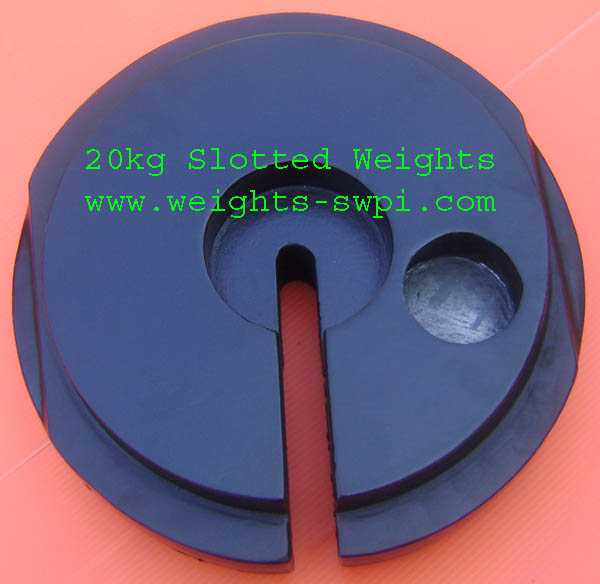The hanger weight is a weight in itself, that also has its weight Calibrated so that the hanger can be used as part of the overall weight under test, and will hold a number of Cast Iron slotted weights depending on its usable shaft lengths. The slotted weights are discs with slots in them and are designed to sit on the hanger. Several Cast Iron Slotted Weights may be used together to build up from a minimum weight to a maximum test load.
These weights are used to test force gauges, crane scales or other suspended weighing scales. Cast Iron Slotted Weights are primarily used to calibrate large capacity scales.
Shanker Wire Products Industries (SWPI) Cast Iron Slotted Weights are manufactured from a high quality iron. The surface are free of cracks, pits and sharp edges. All surfaces are smooth and free of scratches, dents and pores. Weights are protected by a durable coat of paint to protect the casting from rusting.
The M1 Cast Iron slotted hanger weights (Newton Cast Iron Slotted Weights, Kilogram Cast Iron Slotted Weights) are the most common hanger weights we sell and are suitable for testing and calibration in the 5 N / 500 g up to 200 N / 20 kg.
Cast Iron Slotted Weight Hangers:
Cast Iron Slotted Weights are typically used with a hanger that also has its weight calibrated so the hanger can be used as part of the overall weight under test. Weight hangers are available in a variety of lengths and weight capacities. Hangers are calibrated to a mass value, and also have a capacity of how much weight can be loaded onto them.

Calibration Weight Certification:
You will normally need a calibration certificate to satisfy, if the tests that you do are on equipment that can effect the quality of your product and you are audited by an outside organization. Our Calibration Laboratory is NABL accredited in accordance with the standard ISO/IEC 17025 : 2017, So you can be satisfied with the quality and accuracy of the Cast Iron Newton Slotted Weights and Hangers.
Construction and General Shape:
Cast Iron Slotted Weights have adjusting cavities. Each weight has its nominal value cast into the topside of the weight. Weights are protected by a durable coat of paint to protect the casting from rusting.

Click here to enquire about Cast Iron slotted Weights and Hanger:

 represents the mass of the object undergoing an acceleration a {\displaystyle a}
represents the mass of the object undergoing an acceleration a {\displaystyle a}  . As a result, the newton may be defined in terms of kilograms ( kg {\displaystyle {\text{kg}}}
. As a result, the newton may be defined in terms of kilograms ( kg {\displaystyle {\text{kg}}}  ), metres ( m {\displaystyle {\text{m}}}
), metres ( m {\displaystyle {\text{m}}}  ), and seconds ( s {\displaystyle {\text{s}}}
), and seconds ( s {\displaystyle {\text{s}}}  ) as 1 N = 1 kg ⋅ m s 2 . {\displaystyle 1 {\text{N}}=1\ {\frac {{\text{kg}}\cdot {\text{m}}}{{\text{s}}^{2}}}.}
) as 1 N = 1 kg ⋅ m s 2 . {\displaystyle 1 {\text{N}}=1\ {\frac {{\text{kg}}\cdot {\text{m}}}{{\text{s}}^{2}}}.} 


 Magazine: Weights & The Society
Magazine: Weights & The Society